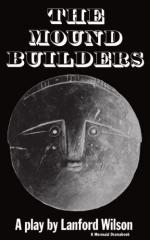5. Ore. Lying near this skull as if they had been placed in the hands of the corpse were two pieces of metallic ore, one of which is before you. A fresh section of it shows it to be Arsenical Iron Pyrites, each piece weighing four or five ounces. No doubt the shining ore and its heavy weight attracted notice, although it is of no commercial value. The probabilities are that this ore was regarded as sacred, and possibly having been considered valuable was placed beside the corpse as the ancient obolus was laid beside the departed Greek to pay his fare to crusty Charon.
[Illustration: Figure 1. Mound builders’ implements.]
Manufactured articles.
1. Stone Implements. The stone articles found, no doubt form a very small proportion of the implements used by the lost race. I am able to show you three classes of implements.
(a.) Scrapers. (See C. Figure 1.) These were made after the same manner and from the same material as the flint arrow heads, found so commonly all over this continent. They are usually of an oval or elongated diamond shape, of various thicknesses, but thin at the edges. Their purpose seems to have been to assist in skinning the game, the larger for larger game, the smaller for rabbits and the smaller fur bearing animals. Probably these implements were also used for scraping the hides or skins manufactured into useful articles.
(b.) Stone Axes and Malls. In the mound on Red River was found the beautiful axe of crystalline limestone, which approaches marble. From the absence of stone so far as we know of this kind in this neighborhood, it is safe to conclude that it came from a distant locality. There are also gray stone celts and hammers used for crushing corn, for hammering wood and bark for the canoes, and other such like purposes, in time of peace; and serving as formidable weapons in time of war. In the mound on the Red River a skull was discovered having a deep depression in the broken wall, as if crushed in by one of these implements.
(c.) Stone Tubes. (See B Fig. 1.) These are among the most difficult of all the mound-builders’ remains to give an opinion upon. They are chiefly made of a soft stone something like the pipestone used by the present Indians which approaches soapstone. The hollow tubes (see figure B.) vary from three to six inches in length, and are about one-half an inch in diameter. They seem to have been bored out




